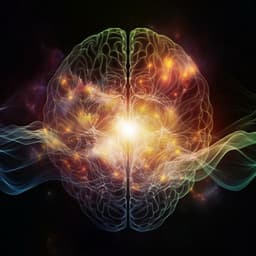
Psychology
Developing cognitive workload and performance evaluation models using functional brain network analysis
S. Shadpour, A. Shafqat, et al.
This groundbreaking study by Saeed Shadpour and colleagues harnesses EEG data to develop models for evaluating cognitive workload and performance while using a robot simulator. Discover how age impacts cognitive challenges and the potential for this research to transform objective assessments in various fields.
Playback language: English
Introduction
Cognitive workload, the mental effort dedicated to a task, significantly impacts learning, performance, and daily activities. Increased task demands strain working memory (WM) resources, leading to higher cognitive workload. Older adults consistently exhibit higher cognitive workloads than younger adults for similar tasks, possibly due to inefficient brain resource utilization. Evaluating cognitive workload has various applications, including improving learning, enhancing performance in demanding professions (aviation, surgery), assessing the potential of video games to delay cognitive decline, and creating early detection models for cognitive decline in the elderly. Studies on the impact of cognitive activities on healthy aging have yielded conflicting results. While some studies suggest that mental exercises, such as playing video games, improve cognitive function and physical health, especially in the elderly, others have found no link between brain-training and generalized cognitive improvement. An objective, evidence-based approach is needed to assess whether brain exercises can help seniors optimize cognitive resources and delay cognitive decline. Current methods for evaluating cognitive workload are often subjective, and limitations in computational algorithms and technical constraints affect the validity of objective methods. EEG signals have been proposed as a potential tool for evaluating cognitive workload, but challenges exist due to the volume conduction phenomenon causing signal leakage. This study aimed to identify specific brain areas responsive to cognitive workload and performance using high-resolution EEG data, mitigating volume conduction issues through a high-density headset and spatial filtering methods. The results could potentially be used to detect cognitive decline by evaluating changes in cognitive workload.
Literature Review
The literature surrounding the effects of cognitive training and video games on cognitive function in aging populations is mixed. Some studies demonstrate a positive correlation between engaging in mentally stimulating activities, particularly three-dimensional video games, and increased gray matter in brain regions associated with memory and reduced risk factors for Alzheimer's disease. Improved attention, memory, mental flexibility, and multitasking abilities have also been observed in older adults who play 3D video games. Conversely, other large-scale studies have found no significant relationship between brain training programs and improvement in general cognitive function, regardless of training duration or intensity. The inconsistency in findings highlights the need for objective measures to evaluate the effectiveness of cognitive interventions and identify early signs of cognitive decline. Currently, cognitive function assessments in primary care settings are largely reliant on subjective reports, potentially leading to underdiagnosis due to factors such as patient awareness, willingness to discuss mental health issues, and social stigma.
Methodology
This study used EEG data from 26 participants (18 males, 8 females; average age 35.5 years) performing two cognitive tasks (Matchboard levels 2 and 3) on a da Vinci Skills Simulator. EEG data were recorded at 500 Hz using a 124-channel headset (AntNeuro®), with Cz as the reference. After removing poor-quality signals, artifact correction was performed using blind source separation and topographical PCA. Spatial Laplacian was applied to mitigate volume conduction effects. Search information, strength, temporal network flexibility, integration, recruitment, and PSD features were extracted at four frequency bands (theta, alpha, beta, gamma) across 21 Brodmann areas (BA). Performance scores were generated by the simulator based on several weighted metrics (time, economy of motion, collisions, force, out of view, workspace range, drops). Cognitive workload was assessed using the SURG-TLX questionnaire after each task. Three approaches were used for model development:
**Approach A:** Seven-fold cross-validation and forward feature selection were used to build linear random intercept models for performance and cognitive workload.
**Approach B:** GLMM-LASSO was applied to 96 features (average features across four brain cortices and four frequency bands) to build models. Outliers were removed using the LOF algorithm.
**Approach C:** This repeated Approach B but used data from only 32 EEG channels selected according to the international 10-20 system. The GLMM-LASSO model was used to develop models for performance and cognitive workload.
Pearson correlation was used to assess the relationship between age, performance, and cognitive workload.
Key Findings
**Matchboard Level 2:** Average temporal network flexibility in BA 45 (beta-band) was positively associated with performance. Average search information in BA 47 (theta-band) was negatively associated with cognitive workload. The pseudo R² was lower for performance (0.72) than cognitive workload (0.95), suggesting better explanation of workload variations.
**Matchboard Level 3:** Multiple features were associated with both performance and cognitive workload, reflecting the task's increased complexity. Positive associations were observed between performance and average temporal network flexibility in BA 9 (theta-band), while negative associations were found between performance and recruitment in BA 47 (theta-band) and search information in BA 37 (gamma-band). Cognitive workload was positively associated with search information in BA 45 (gamma-band) and negatively associated with temporal network flexibility in BA 44 (gamma-band) and BA 7 (beta-band). Pseudo R² was lower for performance (0.55) than cognitive workload (0.88).
**Approach B (GLMM-LASSO with all features):** Models achieved high R² values (0.97 for cognitive workload in level 2, and 0.95 for level 3). Several features, including PSD and functional brain network features, were significant predictors.
**Approach C (GLMM-LASSO with reduced EEG density):** Models still showed significant relationships between features and performance/workload despite the reduced electrode density. However, the specific features and brain regions differed from Approach B.
**Age and Cognitive Workload:** A significant positive correlation (r = 0.54, p = 0.01) was found between age and cognitive workload only for Matchboard level 3, suggesting that challenging tasks could be useful for detecting age-related changes in cognitive workload. No significant correlation existed between age and performance or cognitive workload in Matchboard Level 2.
Discussion
This study demonstrates the effectiveness of combining spectral and functional brain network analyses of EEG data to create robust models for evaluating cognitive workload and performance. Both PSD and functional brain network features independently showed strong predictive abilities. Integrating both types of features further improved model performance, especially for the more complex Matchboard level 3 task. PSD features provide insights into power distribution across different brain rhythms, while functional network features capture the dynamic interactions between brain regions crucial for complex cognitive processing. The superior predictive power of functional brain network features for the more complex tasks highlights their importance in reflecting the brain's dynamic adaptation to varying cognitive demands. The finding of a significant correlation between age and cognitive workload for the more difficult task suggests that challenging cognitive tasks may be useful for detecting subtle age-related changes in cognitive function. The ability to obtain meaningful results from a reduced density EEG system suggests the potential for wider practical applications of this approach.
Conclusion
This study successfully demonstrated the use of combined EEG features (from functional brain network and spectral analyses) for objective assessment of cognitive workload and performance. The findings underscore the complementary nature of PSD and functional brain network features, indicating the importance of using both for a comprehensive understanding. Future research should focus on validating these models with larger, more diverse samples including older adults and individuals with cognitive impairment. Exploring different game complexities and education levels would also enhance the generalizability of these findings. These advancements hold potential for a new era of objective cognitive workload and performance monitoring, contributing to the early detection and management of cognitive decline.
Limitations
The study's relatively small sample size (26 participants) and the age distribution (mostly young adults) limit the generalizability of the findings. The majority of participants were young, healthy, and well-educated, limiting the applicability of these findings to other populations. Future studies should involve larger and more diverse samples, including a greater representation of older adults and individuals with cognitive impairments to validate the models and assess their robustness across different demographics and cognitive states. While SURG-TLX is a validated measure, relying on self-report introduces subjectivity. Future research should explore incorporating objective physiological measures to complement self-reported workload assessments.
Related Publications
Explore these studies to deepen your understanding of the subject.







